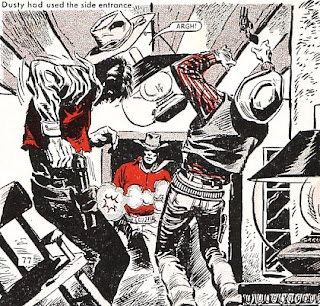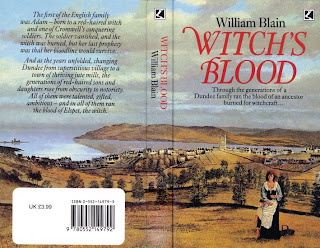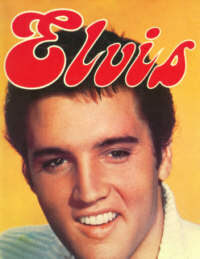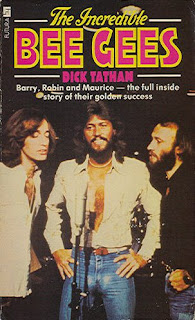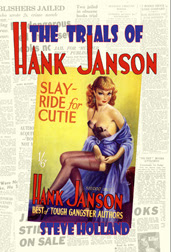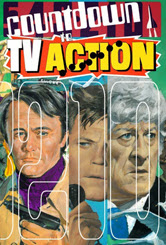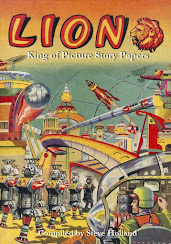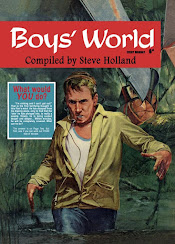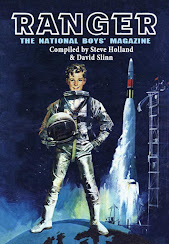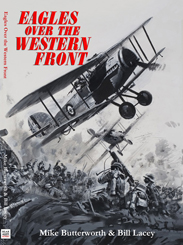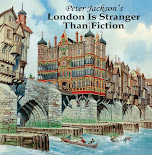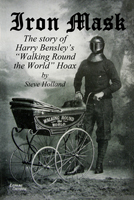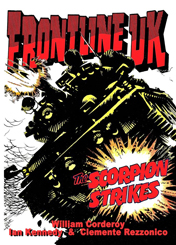 Another mystery writer from the Edwardian age that has been causing the Crime Fiction Bibliography brains trust some hair pulling. This one we've yet to resolve so if you don't like mysteries that are left hanging, just read the Eagles strip. Move right along. Nothing to see here.
Another mystery writer from the Edwardian age that has been causing the Crime Fiction Bibliography brains trust some hair pulling. This one we've yet to resolve so if you don't like mysteries that are left hanging, just read the Eagles strip. Move right along. Nothing to see here.Albert Dorrington wrote novels, pulp stories and other fiction, including, it would appear, a little fiction about his upbringing. So far we've established that he was born in 1859, 1868, 1870, 1871, 1872, 1873, 1874, 1875 and 1876, according to various resources. Usually, it's just a case of checking in the birth records to see which is right, but with Albert Dorrington that's proving to be just one of the problems.
The BMD records have a number of Albert Dorringtons born in around that period, a couple of which can be immediately ruled out:
Albert Dorrington (b. Derby, 1Q 1866)
Albert Dorrington (b. Salisbury, 3Q 1866)
Albert Dorrington (b. Bishops Stortford, 4Q 1869) (d. Bishops Stortford, 2Q 1870)
Albert Dorrington (b. Kensington, 4Q 1874) (d. Kensington, 4Q 1874)
I can't find anyone with the middle name Albert until Charles Albert Dorrington was born in 1879 (much too late, even with the spread of years given above). So these seem to be the four suspects and we've narrowed it down to two already. There's an Albert Dorrington who married in Derby in 3Q 1885 which might be our first guy, in which case he's not our man, for reasons I'll come to shortly.
The records are imperfect as can be seen by a look at the death index: there's an Albert Dorrington who died at Portsea in 1882 aged 10... but no sign of his birth 10 years earlier in 1871/72. It could be that this Albert Dorrington was born abroad.
The most comprehensive study of Dorrington is probably the entry in Australian Dictionary of Biography (Volume 8, 1981) penned by Ken Stewart. Stewart claims that Dorrington...
was born probably on 27 September 1874 at Fulham, London, son of William Dorrington, policeman, and his wife Hannah, née Byford. He was educated at King Edward's School, Birmingham. When he was about 16 he 'drifted' to Australia where, after brief stays in Melbourne and Adelaide, he travelled through German settlements in South Australia; in Queensland, the Torres Strait, and Palmerston (Darwin); and in outlying settlements in South Australia, supporting himself through canvassing and other jobs. Germans, Chinese, Kanakas, Afghans and Japanese, often unpleasantly perceived, populate much of his fiction. In 1899 Dorrington settled at Waitara, Sydney, where he lived with Leonora Anderson, who bore him several daughters. For seven years he replated silverware for a Pitt Street company.This does not entirely match the entry compiled by AusLit, which claims he was born on 14 August 1871 in Stratford-upon-Avon, Warwickshire, and died in Ruislip, London, on 9 April 1953. It reproduces a biographical note from The Bulletin Story Book (1901), which states that he...
Attended King Edward Grammar School, Birmingham, until his sixteenth year. Came to Australia in 1884; and, after many unsuccessful bids for fortune in Melbourne and Adelaide, began a tour through Australia as a newspaper and general advertising canvasser. Within two years had wandered from Adelaide to Bourke, from Bourke to Torres Straits, working the back towns, and thereby gaining a knowledge of bush life. In 1895 began contributing to the Bulletin. Now [1901] in business in Sydney, devoting his spare time to literature.A note at AusLit reads: "Most sources give 1874 as the year of Dorrington's birth, but the Bulletin Story Book has it as 1871, as does Dorrington's entry (in his own hand) in A. G. Stephens's Australian Autobiographies, vol.1. (The latter source also states the day and month of his birth as 8 August.)"
It's worth noting here that the Bulletin biography says he attended school until he was 16 but does not state that he immediately went to Australia, but this, I suspect, is where the notion that he was born in 1868 comes from (1884 minus 16). The Bulletin entry is mathematically wrong: if Dorrington was born in 1871 and went to Australia in 1884, he could not have remained at school until 16. And, according to the Author's and Writer's Who's Who he attended the Oratory School in Birmingham, not a Grammar School.
Back to the Australian Dictionary of Biography where we learn more of Dorrington's early career...
Dorrington started writing for the Bulletin in the late 1890s, often as 'A.D.' or 'Alba Dorian'. After 1900 he also contributed to such publications as the Freeman's Journal, the Australian Worker, Steele Rudd's Magazine and the Bookfellow. Among his close friends were James Dwyer and Victor Daley; he perceived, ahead of his time, the literary sophistication of Joseph Furphy. A. G. Stephens promoted Dorrington's early fiction, publishing Castro's Last Sacrament, and Other Stories (1900), and collaborating to write a romantic novel, The Lady Calphurnia Royal, serialized in the Bookfellow in 1907, and published in London in 1909. The two quarrelled bitterly for decades, first in Australia over personal matters, and later concerning arrangements for the novel's publication in Britain and the United States of America. Dorrington had left Australia in 1907, arguing that local conditions provided 'no opening'; that Australian critics neglected promising writers other than those of assured position; and that cheap English periodical literature had swamped the local market.Al Hubin tells me that AusLit lists 328 works (mostly columns and short stories) by Dorrington under various names including Alba Dorian, Alba Dorrington, Alba and Alba D.
The Author's and Writer's Who's Who mentions that he was commissioned by the Sydney Bulletin to report on whaling in 1906; Stephen Martin, in The Whales' Journey (2001) says his visit to Twofold Bay was in June 1908 and that Dorrington, "repelled by the stench of the whaling station, but perhaps also influenced by the desire for sensation", wrote up a lurid account of his visit:
Whale offal clings and rots where it holds. On Judgement Day, when the Angel of the Apocalypse has poisoned the land and sea, the Devil will smother mankind with the vitals of the whale.A photograph captioned "Lawson and friend Albert Dorrington at Circular Quay, Sydney, 1908" appears in A Fantasy of Man: Henry Lawson Complete Works, 1901-1922,, ed. Leonard Cronin (Lansdowne, 1984). Both these notes seem to imply that Dorrington was still in Australia in 1908, despite the information elsewhere that he left for London in 1907.
However, John Herrington points me to a shipping manifest for the Ophir, which arrived in London on 7 May 1907 carrying a Mrs. Dorrington and her two infants (who started their journey in Sydney; and a Mr. A. Dorrington (who was picked up in Columbo).
After visiting Ceylon, Dorrington settled near London, and published a misleading account of allegedly exotic colonial hard-ships as an orchardist, which Stephens in Australia exposed and derided. Later Stephens, Louis Becke and Randolph Bedford accused Dorrington of plagiarism; but in London he gained recognition for newspaper serials, in the Daily Telegraph and elsewhere, and for stories for the Pall Mall Magazine and other magazines.Dorrington's first British novel, And the Day Came was published in 1908. His stories also appeared in Blackwood's and Chamber's Journal but, despite a fairly prolific output of novels over the next few years and Stewart's fairly rosy picture of him ("He remained a Fleet Street journalist"), his career proved none too successful and at around the beginning of the Great War, he had to apply to the Royal Literary Fund. According to the Oxford Companion to Edwardian Literature...
he stated to the Royal Literary Fund that he had 'known no other profession than that of literature'. In the ten years before 1914 he was earning £400 a year, the war reduced this to £30 a year, with the consequence that he, his wife and three daughters were evicted from their house in Bournemouth. He also applied to the Society of Authors and the Professional Classes War Relief Council for support.Dorrington was, as noted above, married with three children. He had lived in Waitara, Sydney, between 1899 and 1907 and was living with Leonore Anderson in around 1901, although the two were not married and there is no trace of a marriage certificate. Two daughters were born in Australia, Marjorie (also known as Deborah) Anderson (b. Petersham, 1902) and Leonore (also known as Leonore Patricia) Anderson (b. Sydney, 1904), and a third, Madeline (also known as Georgina Madeline) Dorrington, in Brighton, Sussex, in 1909.
In August 1915, he travelled to America, the shipping manifest describing him as a 43-year-old war correspondent and novelist (implying he was born in 1871/72); he was joined in February 1916 by his wife and daughter Madeline. Leonore gave their address as 60 Alfred Road, Feltham, Middlesex. Mother and daughter returned in May 1916, followed by Albert in August (now aged 44), who gave his permanent address as 9 Grafton Street, London.
(A brief aside: Mum gives her age as 31, meaning she was born 1884/85; in the 1911 census she is 27, thus born 1883/84, and implying she was still in her teens when she began living with Dorrington. In fact, she was born Leonore A. Anderson, the daughter of Henry D. and Emma I. M. Anderson, in Sydney in 1883.)
Dorrington had already had some success in America, selling stories to Red Book, Popular Magazine, The Cavalier (where his novel, The Velvet Claw, was serialised in 1912), Top-Notch and Short Stories. Over the next few years, he appeared in Argosy, All Around Magazine, People's, All-Story Weekly, Western Story Magazine, Sea Stories and others. His writing career seemed to pick up and he also sold to various magazines in the UK (amongst them Detective Magazine and Happy Magazine) in the 1920s as well as reviving his career as a novelist.
 In August 1922, the engagement of Leonore Patricia Dorrington and Archer Jack Greathed (b. Hereford, 1900) was announced. Greathed was an accountant and broker who travelled to Venezuala that month, subsequently joined in 1923 by Leonore Dorrington and her mother. The couple had two daughters, Rosemary Jane (b. Curacao, West Indies, c.1925) and Janet Eve (b. Vancouver, Canada, 1931); the family had moved to Canada in 1927, and Archer worked as an accountant for Glen Waghorn & Co. of Vancouver until emigrating to America in November 1931.
In August 1922, the engagement of Leonore Patricia Dorrington and Archer Jack Greathed (b. Hereford, 1900) was announced. Greathed was an accountant and broker who travelled to Venezuala that month, subsequently joined in 1923 by Leonore Dorrington and her mother. The couple had two daughters, Rosemary Jane (b. Curacao, West Indies, c.1925) and Janet Eve (b. Vancouver, Canada, 1931); the family had moved to Canada in 1927, and Archer worked as an accountant for Glen Waghorn & Co. of Vancouver until emigrating to America in November 1931.The marriage appears to have broken down soon after. Archer Greathed returned to Canada and went on to marry Mary Gladys Laird and have two further children before serving with the Queen's Own Rifles of Canada during the war. Rising to the rank of Major, he was killed on the Western Front in Holland on 21 January 1945, aged 44.
Leonore Patricia, meanwhile, also remarried, to Colonel Rowland Shand Kydd, at Marylebone, Loneon, in 1934, although was still listed as Leonore Dorrington when she travelled to Gibraltar in January 1935, her intended permanent home being Spain. She died in Henley, Berkshire, in 1956.
Deborah M. Dorrington, Albert's elder daughter, I believe to have married Francis H. Cunnack in Falmouth in 3Q 1928. Madeline, the younger daughter, is said to have moved to Canada in the 1950s.
When Albert's second daughter's engagement was announced, he was described as "of Ruislip" in the announcement. Albert Dorrington had found a permanent home at Waitara, Ickenham Road, Ruislip, Middlesex. Waitara had, of course, been where he had lived whilst in Australia. It seems that Albert lived here for the rest of his life and his death is registered at nearby Harrow in 2Q 1953. Albert is said to have died at Ruislip on 9 April 1953. In yet another twist to the confusion over his birth, the register gives his age at death as 94 (i.e. born c.1858).
Which brings us back to where we started. Dorrington had himself written that he was born in 1871, which ties in with the ages he gave when he travelled to America. But Dorrington also presumably supplied the information to The Author's and Writer's Who's Who for 1935/36 that he was born in Stratford-upon-Avon in 1876 (seeming to correct the information in the 1934 edition that he was born in 1870). And perhaps to Who's Who in Australia, which listed him from at least as early as 1935 and at least as late as 1950, where his year of birth was given as 1875. The same year was given by Who's Who in Literature.
The Australian Dictionary of Biography would appear to offer confirmation of his date of birth by listing the names of his parents, William and Hannah. But could this information have been taken from a birth certificate? If it was, as I suspect, the birth certificate of Albert Dorrington whose birth was registered in Kensington in 4Q 1874, the information is almost certainly wrong: that Albert Donnington died at birth or shortly after as his death is also registered that same quarter.
William Dorrington was born in Romford, Essex, in 1851 and married Hannah Byford, born in Sudbury, Suffolk, in 1850. Their marriage was registered in Romford in 2Q 1872. If I'm right, their first son Albert was born in Fulham in 1874 and died soon after; a second son, Ernest Harry Dorrington, was born in Fulham in 1876, and is the only son to be found living with William and Hannah (at 45 Cruikshank Road, West Ham) in the 1881 census. It would appear that William died in 1884 and Hannah followed in 1888. Ernest was an inmate at a boys' home in Kentish Town at the time of the 1891 census and later worked as a soap cutter, living with his uncle in West Ham in 1901.
The fact that this particular Albert Dorrington and his brother were born in London and his parents lived in London flags up a number of questions. For instance, why would Albert Dorrington subsequently claim he was born in Warwickshire rather than London, and why would he attend a school in Birmingham? The London birth on 27 September also disagrees with the birth day (14 August) that Dorrington gave for himself.
School attendance in Birmingham makes his birth in Stratford-upon-Avon seem far more likely; in the Author's and Writer's Who's Who he claims Stratford in 1876, information that surely would have come from the author himself. I'm inclined to believe that, whilst people lie about their age, they tend not to change their place of birth.
Dorrington nowadays is remembered in the UK and USA for minor contributions to the crime and science fiction genres. His The Radium Terrors (first serialised in Pall Mall Magazine (UK) and The Scrap Book (US) in 1911 and published in book form in 1912) is a mix of both, concerning the robbery of a vial of radium by a Japanese master crook named Dr Tsarka. He has a far better reputation in Australia for his writings around the turn of the last century; several of his stories have been reprinted in anthologies although, as far as I can tell, only The Radium Terrors remains in print (as an out of copyright POD book).
For such a minor author, he's caused an awful lot of heads to be scratched over the years...
Update - 10 March 2012: Throwing a further spanner in the works... Thanks to Alex (see comments) I've taken a look at an online family tree that includes Albert Dorrington, which states that he was born in 1873 and his birth was registered in Sudbury under the name Albert Byford. There is certainly such an entry in the official records (4Q 1873). The tree confirms his parents as William Dorrington and Hannah, née Byford, who were married in 1872... so why Albert would be registered under his mother's maiden name I've no idea; a birth in 4Q 1873 is well over nine months after a marriage in 2Q 1872.
I'm not convinced that this resolves the mystery... it just adds another twist and implies that he was only ten or eleven when he travelled to Australia (if the 1884 date is to be believed). Yet more things to scratch your head over...
 Novels
NovelsAnd the Day Came. London, Hutchinson & Co., 1908.
The Lady Calphurnia Royal, with A. G. Stephens. London, Mills & Boon, 1909; as Our Lady of Darkness, with A. G. Stephens. New York, The Macaulay Co., 1910; London, Wright & Brown, 1931.
Children of the Cloven Hoof. London, Mills & Boon, 1911 [1910].
Our Lady of the Leopards. London, Mills & Boon, 1911.
The Radium Terrors. London, Everleigh Nash, 1912; illus. A. C. Michael, Garden City, N.Y., Doubleday, Page & Co., 1912.
A Door in the Desert. London, Hutchinson & Co., 1927.
The Moon-Dial. London, Methuen & Co., 1928.
The Fatal Call. London, Methuen & Co., 1929.
Madonna Island. London, Wright & Brown, 1932.
The Velvet Claw. London, Wright & Brown, 1932.
The Half-God. London, Wright & Brown, 1933.
A Mirror in Chinatown. London, Wright & Brown, 1933.
Collections
Castro's Last Sacrament and other stories. Sydney, Bulletin Newspaper Co., 1900.
A South Sea Buccaneer. London, Andrew Melrose, 1911.
Stories to the Master. London, Mills & Boon, 1926.
Others
The Diamond Ape [by A. Dorrington] and other tales in the intermediate style of Pitman's Shorthand. London, Sir I. Pitman & Sons, 1920.























